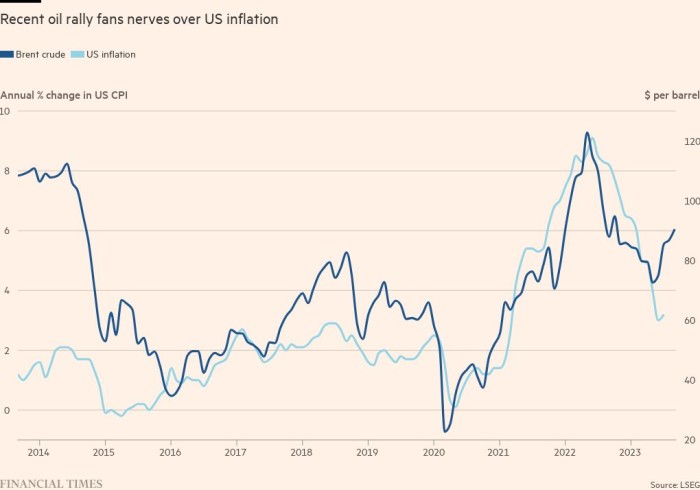Receive free Markets updates
We’ll send you a myFT Daily Digest email rounding up the latest Markets news every morning.
Over the summer, a certain familiar fairy tale kept cropping up in financial markets: Goldilocks.
Key economic data releases were neither too hot nor too cold, but just right, like the porridge sampled in the story by the plucky young eponymous hero. Jobs and inflation figures were bright enough to suggest the US economy, in particular, was successfully withstanding the Federal Reserve’s scorching campaign of interest rate rises, and dull enough to suggest the central bank might not need to do too much more before inflation gets back in its box.
Now, summer is over, the tans are fading, and investors have remembered that at the end of the Goldilocks story, a small child is scared out of her wits by hostile animals chasing her into the forest. Sure, the kid nicks a bit of porridge, breaks a chair and briefly exercises her squatter’s rights in a woodland cottage, but ultimately, the winners in this tale are the bears.
So it is too in markets. August delivered the first monthly drop in the benchmark S&P 500 index since February, and the opening days of September have been weak on both sides of the Atlantic. We have reached, wrote strategist Bhanu Baweja and colleagues at UBS, “Peak Goldilocks”.
The oil price is helping to fan nerves. Brent crude cracked above $90 a barrel this week for the first time since November, after Saudi Arabia and Russia said they would extend supply cuts. That benchmark has now climbed by a quarter since June, rekindling concerns that the inflation bogeyman is down but not out.
Suddenly the story investors are telling themselves to help understand what fickle markets are up to has shifted. Should this matter? Arguably not. But when everyone is trying to spot how and when growth and perky inflation will give way to an elusive US economic downturn, it does. “It’s a narrative-driven market,” said Salman Ahmed, global head of macro and strategic asset allocation at Fidelity International.

Over the past couple of months, the main narrative has centred on a soft landing, where central banks succeed in taming inflation without burning jobs or sparking a serious economic pullback.
Certainly, the pessimists this year got it wrong. The US has dodged recession, comfortably, and stock markets have swept higher, defying consensus expectations for a decline. Ahmed is happy to admit he made the same mistake, having given up on his call for a 2023 recession in June. But he remains convinced the damage from the Fed’s aggressive series of interest rate rises will come.
Up until now, growth-focused equities and risky bits of the corporate bond markets — still supported by excess liquidity in the financial system and enthusiasm around artificial intelligence — have been performing as if the rate rises we have seen so far do not really matter. It is hard to imagine that can last for ever, particularly when all those shakier companies that feasted on cheap money after the Covid pandemic come to refinance that debt at higher rates in the next year or two.
Ominously, the pain is already evident in Europe, where stocks have stagnated and the euro has been dribbling lower against the all-conquering dollar for weeks. “Europe is in an interesting moment and a complicated situation,” said Gustavo Madeiros, head of research at Ashmore. “The impact of the hikes is felt much earlier in Europe, where the vast majority of lending is short-term bank loans.” Poland’s bumper rate cut this week could end up as a cautionary tale for what lies ahead in more developed markets.
Suddenly, market participants are finding it easier to rattle off reasons for caution. The oil price is one of them. A spike in European gas prices this week also brings a sense of déjà vu. China’s economy is very clearly under strain and is piling additional stress on the crucial industrial sector in Germany. Even Apple — considered something of a haven stock over recent years — dropped by 7 per cent this week after Chinese authorities pressed state employees to stop using iPhones. That’s a cool $200bn hit and a big challenge to US markets that rely heavily on a tiny clutch of tech stocks.

Even good news is bad news now. Data on Wednesday showing that the US services sector is in surprisingly rude health knocked stocks because investors are worried that the Fed has not done enough yet to hold inflation durably lower. Instead it will probably have to keep the pressure up, for longer.
It is all sounding rather reminiscent of 2022 — a dreadful year for investors who had to deal with sinking stocks and a decline in bond prices. This time is different, in the sense that the 13 per cent climb in global stocks so far this year offers a cushion, as do the bumper yields on even the safest government debt.
If you are willing to hold those bonds to maturity, you have nothing to worry about. But the Bank of America pointed out this week that we’re well on track for the third down year in a row for the US 10-year Treasury bond — a losing streak previously unmatched in the entire 250-year history of the US republic.
Unless stocks can pull off a fairy tale ending to this year, 2023 could shape up to be drab yet again.
katie.martin@ft.com








